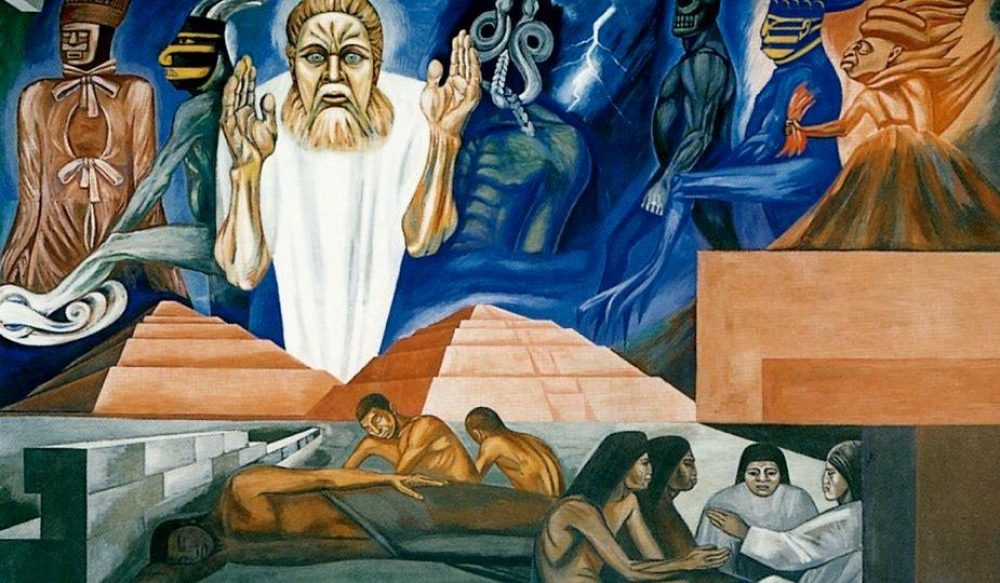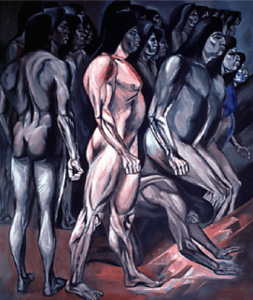The basement of the Baker Library, the academic heart of Dartmouth, houses the nationally recognized Epic of American Civilization by Jose Clemente Orozco. This fresco is a well known art piece on campus and is predominately appreciated as such. However, the Orozco murals have a lesser known counterpart known as Walter B. Humphrey’s “Hovey Murals.” The purpose of this essay is to delve into the fruition and authorization of The Epic of American Civilization at Dartmouth College and how the consequent choice of censorship—or lack their of—was made. First, I will discuss the history behind the mural then I will provide description of the art piece. Then I will talk about the response these mural provoked. Ultimately, I will conclude with how choice that determined the accessibility of the Orozco murals resulted in the general awareness and familiarity to students across campus.
In order to fully grasp the materialization of the “Hovey Murals,” The Epic of American Civilization must be discussed. The Orozco murals were a result of a larger campaign in the United States. In the 1930s there was a new federal commitment to public art due to the Great Depression. This is what influenced art professors to persuade their academic administrations for the funds to bring Mexican artists to U.S. colleges. Art history professors Artemas S. Packard and Churchill P. Lathrop, approached Orozco with the support of President Ernest Hopkins to be a visiting artist at Dartmouth College. The motivation to bring in Orozco stemmed from the concerns of the art history professors. Both were concerned that students wishing to learn about an artist’s studio activities had no resource for academic support. In archived records, Churchill Lathrop mentions, “Early in 1932, we had a brilliant revelation, an idea that might move the stalled project off dead center. The department had a small lecture budget; so, why not invite Orozco to give a lecture-demonstration on fresco painting? Such an unusual lecture, by a scholarly artist, would attract considerable student and community attention, and it would produce a few square feet of fresco: a small sample mural. Work-in-progress on even a small mural would have educational value. Also, the presence of Orozco would give the community the chance to observe his skill and judge his character.” This was the genesis of the Orozco Murals.
Once Orozco had had some time on campus, he showcased his sample work in the library corridor. The undergraduate body became tremendously impressed with him and his technique. There are accounts of while he was working, students would gather in numbers to watch Orozco paint. It was after this that Orozco himself proposed the murals that would The Epic of American Civilization. According to documented conversation, President Hopkins states that Orozco came to him with a portfolio and a plan for some murals that he’d been carrying around. For years Orozco was looking for the proper wall space and told Hopkins the basement of Baker library was perfect for what he had envisioned. Hopkins then authorized these paintings for Dartmouth College.
In addition to funding from the college, there was outside funding. Chief among this was the funding provided the Rockefeller family. Nelson Rockefeller, Dartmouth Class of 1930, had been a student of Lathrop’s, and a tutorial fund for special educational initiatives set up by Nelson’s mother, Abby Aldrich Rockefeller, would ultimately make the commission possible. Once Orozco had preliminary sketches drawn, they were published in The Dartmouth. It was at this moment that this piece of art became controversial.
According to Mary Coffey, “Orozco presents America’s epic as cyclical in nature, the eternal return of destruction and creation, rather than a linear tale of democratic expansion and progress.” I like this description of the murals because it articulates precisely how Orozco illustrates a sense of time. He divides the basement into two parts, the “ancient” and “modern” epochs. Orozco further exploits his idea of cyclical time by drawing analogies between the two periods with coordinating color and certain details. Furthermore Coffey states, “Ancient America begins with the migration of peoples into the Central Valley of Mexico and the arrival of Quetzalcoatl, an enlightened deity who establishes a Golden Age in which the arts, agriculture, and society flourish. Quetzalcoatl’s departure marks the decline of the ancient world and its destruction by conquistadors enacting Aztec portent. Modern America begins in Christian conquest, presided over by Cortez, Quetzalcoatl’s antiheroic counterpart.” It is after this moment in the mural that the panels shift to modernity’s dark lens. Human industry is developed;
“individuality is deadened by a consensus society and the regimentation of standardized education. The cycle culminates in the blind fury of nationalist war and a Christian apocalypse.” (Coffey) The mural comes full circle when the resurrected Christ destroys what he helped to create like Quetzalcoatl before him. He chops down his cross and “migrates” the spirit toward a new millennium in which modern industrial man might bring about another Golden Age. (Coffey) The points about education, in addition to the depictions of Christ, are what brought the main wave of opposition against the Orozco’s murals.
There was much correspondence between alumni and Hopkins in which they expressed their negative feedback on the content of the murals in relation to Dartmouth culture. One such letter was dated June 3, 1932, from alum Matt B. Jones, president of New England Telephone and Telegraph Company, to President Hopkins. In it Jones states, “My feeling about the murals is that when the College makes them a part of a building it stamps with its official approval of the type of art to which the particular mural belongs. I believe my thought is illustrated by the suggestion that there is no reason why the College should not recognize and teach its students the theories and the polices of Socialism, or Communism, or Nudism, or other isms, but it would be a vey different thing to carve in stone over the doorways of the College buildings the tenets of those various isms because such action would be equivalent in the mind of the average man to the official adoption and the approval of them by the College.” To Jones and many others, the Orozco murals had no place at Dartmouth because they did not, in their minds, depict what the college values were at the time. Additionally, panels of the murals upset some viewers because of the controversial criticisms Orozco paints. Together, these two ideas almost led to the fresco to be painted over. However, it was decided that these paintings would remain accessible to the students and general public.
In retrospect, The Epic of American Civilization became well known to the student body and public because the powers that be decided not to censor them. (This is besides the fact that Orozco was a famous artist beyond Dartmouth in his own right). The ideas portrayed in this mural were deemed not harmful to the college or the public. This is much unlike the “Hovey Murals” which have been forgotten over time due to their partial censorship. Their censorship has led to many of my undergrad peers not being aware of the “Hovey Murals”’s existence. However, it is important to note that the content of those murals are too sensitive to be open freely to students. Therefore, the college had to restrict its access—withdrawing original full authorization—of the murals. All in all, the authorization of the Orozco murals followed by the lack censorship has led to the ultimate acceptance and adoption of the murals into Dartmouth culture.



 the rest of the mural, “Migration” is painted in subdued earthier tones. I believe the most extreme contrast can be seen between “Migration” and “Modern Migration of the Spirit.” I think Orozco meant this dull to vibrant contrast (as well as the similarities in the tiles) to further illustrate the chronological order of the panels in his mural. The colors signify early stages, not necessary of development, but early stages in relation to time. I thought this was an interesting way in which Orozco uses artistic aspects for time representation.
the rest of the mural, “Migration” is painted in subdued earthier tones. I believe the most extreme contrast can be seen between “Migration” and “Modern Migration of the Spirit.” I think Orozco meant this dull to vibrant contrast (as well as the similarities in the tiles) to further illustrate the chronological order of the panels in his mural. The colors signify early stages, not necessary of development, but early stages in relation to time. I thought this was an interesting way in which Orozco uses artistic aspects for time representation.